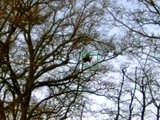EID to unveil new vehicle communication system at DSEI
The Portuguese company’s naval communications system is in service across more than a dozen countries. It has turned to its home nation for support in developing a new vehicle based C2 system.
The US Defense Advanced Research Projects Agency (DARPA) is seeking engineered optical materials to develop smaller, more capable, and lighter devices for advanced imaging applications, it announced on 15 August.
The materials be unconstrained by 'laws' of classical optic design that have long been followed by imaging system developers. One such rule is that imaging systems must be built by linearly arranged, complex and precisely manufactured optical elements. This results in high-performance imaging devices becoming large and heavy with multiple optical elements.
DARPA is seeking material for its Extreme Optics and Imaging programme, which aims to break away from the paradigm and introduce new engineered optical materials (EnMats) and associated design tools. These tools will help develop new optical systems with reduced weight and size, new functionalities and performance improvements.
Extreme is focused on two-dimensional meta-surfaces and 3D volumetric optics and holograms that manipulate light in ways beyond the conventional reflection and refraction rules. It will address multi-scale modelling to enable EnMat design and optimisation across various size scales.
The programme aims to develop and demonstrate an optical system with engineered surfaces, in which light propagation control can be controlled irrespective of a specific geometric shape. It also aims to demonstrate a sugar cube-sized or larger volumetric optical element that can simultaneously perform multiple functions in the infrared and visual bands, such as polarisation measurements, spectrum analysis and imaging.
If successful, the Extreme programme could lead to the development of lighter and smaller optics and imagers for defence applications, enabling miniaturisation of imaging systems for intelligence, surveillance, and reconnaissance. The devices could also improve imaging systems such as IR search and track systems, hyperspectral imagers and night vision goggles.

The Portuguese company’s naval communications system is in service across more than a dozen countries. It has turned to its home nation for support in developing a new vehicle based C2 system.

The Vision4ce Deep Embedded Feature Tracking (DEFT) technology software is designed to process video and images by blending traditional computer vision with artificial intelligence (AI) algorithms to present actionable information from complex environments.

Persistent Systems has been cleared by National Security Agency (NSA) to transmit sensitive data on commercial networks. The devices are added to the NSA’s Commercial Solutions for Classified (CSfC) component list which also includes other companies’ products providing the same security.

The release of the UK’s Strategic Defence Review (SDR) has been long promised as mid-year. It is possible it could be as early as 2 June although the UK Ministry of Defence (MoD) continues to play its cards close to its chest.

Intelsat outlines how its multi-orbit SATCOM architecture is enhancing connectivity and resilience for special operations forces operating in degraded and contested environments.

Next-Generation Overhead Persistent Infrared (Next-Gen OPIR) satellites are intended to provide early warning of missile launches from any location worldwide and new ground stations will result in expanded coverage of critical missile warning.